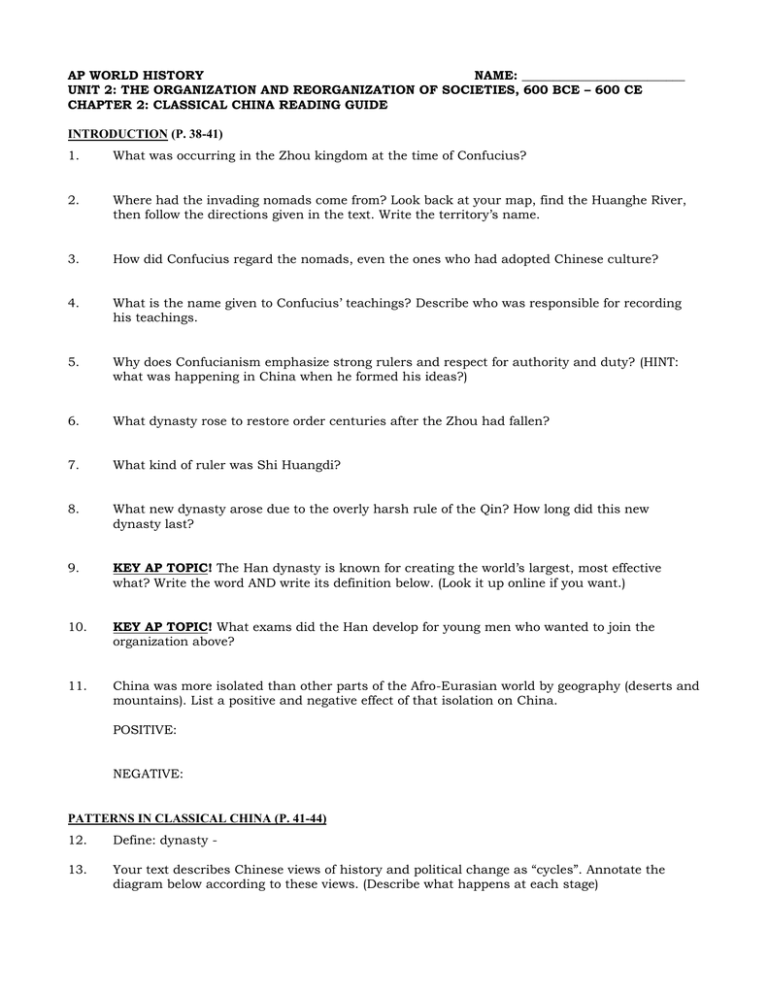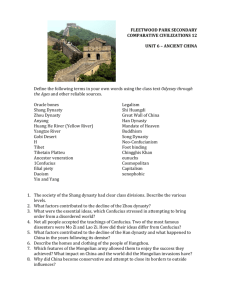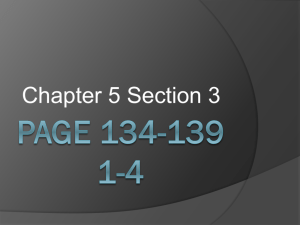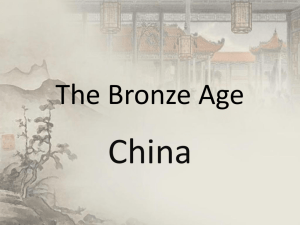APWHU2Chapter2ReadingPacket
advertisement

AP WORLD HISTORY NAME: __________________________ UNIT 2: THE ORGANIZATION AND REORGANIZATION OF SOCIETIES, 600 BCE – 600 CE CHAPTER 2: CLASSICAL CHINA READING GUIDE INTRODUCTION (P. 38-41) 1. What was occurring in the Zhou kingdom at the time of Confucius? 2. Where had the invading nomads come from? Look back at your map, find the Huanghe River, then follow the directions given in the text. Write the territory’s name. 3. How did Confucius regard the nomads, even the ones who had adopted Chinese culture? 4. What is the name given to Confucius’ teachings? Describe who was responsible for recording his teachings. 5. Why does Confucianism emphasize strong rulers and respect for authority and duty? (HINT: what was happening in China when he formed his ideas?) 6. What dynasty rose to restore order centuries after the Zhou had fallen? 7. What kind of ruler was Shi Huangdi? 8. What new dynasty arose due to the overly harsh rule of the Qin? How long did this new dynasty last? 9. KEY AP TOPIC! The Han dynasty is known for creating the world’s largest, most effective what? Write the word AND write its definition below. (Look it up online if you want.) 10. KEY AP TOPIC! What exams did the Han develop for young men who wanted to join the organization above? 11. China was more isolated than other parts of the Afro-Eurasian world by geography (deserts and mountains). List a positive and negative effect of that isolation on China. POSITIVE: NEGATIVE: PATTERNS IN CLASSICAL CHINA (P. 41-44) 12. Define: dynasty - 13. Your text describes Chinese views of history and political change as “cycles”. Annotate the diagram below according to these views. (Describe what happens at each stage) New Dynasty: Aging Dynasty: Problems: 14. What are the three dynasties that ruled classical China? 15. Were the Zhou native to China? If not, what does that make them? 16. How did Zhou rulers encourage loyalty? 17. The land in between the Huanghe (Yellow) River and the Yangtze River was known as what? 18. KEY AP TOPIC! This relates to the dynasty cycle diagram above. The Zhou claimed they had a right to replace the Shang as China’s rulers because heaven (the gods) had transferred its mandate (permission) to rule to the Zhou emperors because the Shang were not ruling well. What was this concept called? 19. Give THREE ways the Zhou promoted cultural unity in China? 20. What was the Chinese period between 402 BCE and 201 BCE known as? 21. What does “Qin Shi Huangdi” mean in Chinese? 22. Why did Shi Huangdi purposely appoint (pick) people from non-aristocratic groups to be his officials? (HINT: “aristocratic” means you have lots of land because you were born to it – your father had it before you and your grandfather before him. Aristocrats are usually right below a ruler in power.) 23. Besides expanding the size of China, what was Shi Huangdi most known for and what was its purpose? 24. What was the MAIN reason Shi Huangdi was unpopular? 25. What dynasty replaced the Qin dynasty? How was it established? 26. How did this new dynasty’s rule compare to the Qin’s? 27. What philosophy did the Han focus on? 28. What happened after about 200 years of Han rule (around 220 CE)? (HINT: remember the dynastic cycle) 29. What group overthrew the Han and where did they come from? POLITICAL INSTITUTIONS (P. 44-45) 30. Describe the typical Chinese family of the Qin and Han periods. 31. What did Emperor Wu Ti establish to help select the best bureaucrats? 32. Why were most bureaucrats from the upper classes? 33. The Han period began in 202 BCE. How long did the Chinese bureaucracy established during the Han dynasty last? 34. What does the Chinese proverb “heaven is high, and the emperor is far away” reveal about how much control the government had over ordinary people during the Han period. RELIGION AND CULTURE (P. 45-48) 35. “The Chinese during the Zhou dynasty were very religious.” Assess the validity of that statement. (i.e., explain whether it’s true or false and to what extent or to what degree) 36. Define: Secular – 37. Why would a government like the Han encourage Confucian learning? (Be skeptical. There’s a selfish reason why any government would love its people to practice Confucianism.) 38. In what way does Confucianism restrain a ruler and protect the people under him? 39. What rival system of thought developed during the Qin and early Han periods? What is the main idea of this rival philosophy? 40. What was lacking in Confucianism that many ordinary Chinese people needed? 41. What other philosophy filled the need above for many Chinese? Who was its chief promoter? (some texts state he is its founder) 42. Why were emperors not threatened by Daoism? (HINT: look back a paragraph or two and see what Daoism said about politics) 43. What were the Five Classics and what were they used for? 44. Why would Confucianism tend to dissuade Chinese emperors from building massive monuments to themselves, like the pyramids built for the Pharaohs in Egypt? (HINT: this is tough and there’s not a right or wrong answer BUT . . . think about what Confucianism obligated rulers to be or to do for the people and what might be required to build a massive monument. HINT 2: what does an emperor’s monument do for the people?) 45. How far ahead of Europeans in astronomy could you argue the Chinese were? 46. Examine the picture on p. 49, figure 2.2. What can pictures like this tell us about technology during the Han period? (HINT: captions are your friend) ECONOMY AND SOCIETY 47. This is a diagram showing Chinese social structure during the Han period. Notice that peasants are in the middle – something unique to China compared to the West. Where do merchants go on this diagram? Gentry/landowning aristocracy & educated bureaucrats– Peasants – Most Chinese are peasant farmers. “mean people” – those without meaningful skills, included performing artists and slaves. 48. List the technological innovations of the Chinese during the Han period. 49. Describe Chinese families. 50. What child enjoyed the most status in the family? HOW CHINESE CIVILIZATION FITS TOGETHER (P. 52-53) 51. Use the diagram below to describe how the Chinese saw the world during the Han period and still do to an extent today. Label/annotate the inner and outer circles. GLOBAL CONNECTIONS: CLASSICAL CHINA AND THE WORLD (P. 53-54) 52. What has allowed China to support a massive population and some of the world’s largest cities? 53. What happened to many of the technological innovations created in China, like paper and compasses, over time? 54. How were many ideas and inventions spread? 55. What product did China possess that the outside world, even Rome, valued highly? 56. What famous “road” was used to trade with China?







